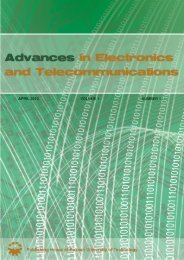november 2010 volume 1 number 2 - Advances in Electronics and ...
november 2010 volume 1 number 2 - Advances in Electronics and ...
november 2010 volume 1 number 2 - Advances in Electronics and ...
You also want an ePaper? Increase the reach of your titles
YUMPU automatically turns print PDFs into web optimized ePapers that Google loves.
REMLEIN AND SZŁAPKA: NEW TAILBITING CONVOLUTIONAL CODES OVER RINGS 57<br />
�<br />
Fig. 2. Encoder of the convolutional code G(D) = 1<br />
from the example.<br />
3+2D+D 2<br />
1+3D+3D 2<br />
Fig. 3. Tree diagram when the zero state response is obta<strong>in</strong>ed X [zs]<br />
4 .<br />
Follow<strong>in</strong>g this description, we show an example of TBR<br />
encod<strong>in</strong>g procedure with feedback systematic convolutional<br />
encoder over r<strong>in</strong>g Z4.<br />
1) Example: A packet of four symbols is encoded. The<br />
symbols belong to the r<strong>in</strong>g Z4. The encoder is a systematic<br />
convolutional encoder over r<strong>in</strong>g Z4 with feedback, with code<br />
rate R = 1/2 <strong>and</strong> two memory elements m = 2. In Fig. 1 we<br />
show the structure of this encoder. We encode the <strong>in</strong>formation<br />
block U = (U0, U1, � U2,U3) � = (1, 0, 3, 3). The state matrix<br />
0 3<br />
is given as A = . Therefore, N = 4, k = 1, <strong>and</strong><br />
1 3 � � � �<br />
4<br />
0 3<br />
from equation (9) we can calculate I2 −<br />
X0 =<br />
1 3<br />
X [zs]<br />
� �<br />
2 1<br />
4 . From this formula we obta<strong>in</strong>: X0 = X<br />
3 3<br />
[zs]<br />
4 .<br />
Therefore, we have to calculate the state X [zs]<br />
4 .<br />
From Fig. 2 we can see that this state is equal to (3, 1) T<br />
<strong>and</strong> the correct state from which � we�must � �start<br />
�the encod<strong>in</strong>g �<br />
2 1 3 3<br />
process is equal to X0 =<br />
= . From<br />
3 3 1 0<br />
Fig. 3 we can see that, if we start to encode the sequence U<br />
from state (3, 0) T , then after N = 4 cycles we reach the same<br />
state <strong>and</strong> obta<strong>in</strong> valid codeword V = (13, 02, 31, 30).<br />
III. SEARCH RESULTS<br />
In this section we present the results of computer search for<br />
the best tailbit<strong>in</strong>g codes over r<strong>in</strong>gs modulo-M for transmission<br />
over AWGN channel. As the quality criterion we take the<br />
m<strong>in</strong>imum Euclidean distance de_m<strong>in</strong>. We compute the m<strong>in</strong>imum<br />
Euclidean distance as the m<strong>in</strong>imum distance over all<br />
pairs of dist<strong>in</strong>ct codewords [10]. Each coded sequence must<br />
be comparedto all the other coded sequences. The codes were<br />
generated by the feedback systematic convolutional encoder<br />
�<br />
Fig. 4. Tree diagram for proper encod<strong>in</strong>g process for tailbit<strong>in</strong>g codes over<br />
r<strong>in</strong>g Z4.<br />
overr<strong>in</strong>g.An exhaustivesearchwas used to f<strong>in</strong>d TBR codes<strong>in</strong><br />
Fig. 4. The object of search <strong>in</strong> this article were tailbit<strong>in</strong>g codes<br />
over r<strong>in</strong>g Z4, generated by concatenation of the systematic<br />
encoders with feedback with code rate R = 1/2 <strong>and</strong> 16-<br />
QAM modulator.Thefoundencodershave m memorycells, S<br />
states <strong>and</strong> k <strong>in</strong>puts. N denotes the length of the <strong>in</strong>put symbol<br />
sequence of k <strong>in</strong>formation bits per symbol. For codes over<br />
r<strong>in</strong>g, feedback coefficients f0 ∼ fm <strong>and</strong> the coefficients <strong>in</strong> the<br />
systematic branches g k 0 ∼ gk m<br />
are written as a sequence of<br />
decimal <strong>number</strong>s.<br />
The coefficients equal to zero at the beg<strong>in</strong>n<strong>in</strong>g of the<br />
sequence are skipped <strong>in</strong> the description. All TBR codes over<br />
r<strong>in</strong>g found for 16-QAM are presented <strong>in</strong> Table I. We found<br />
the best TBR codes for encoders with 16, 64 <strong>and</strong> 256 states.<br />
All of these TBR codes are the new codes that have not been<br />
published yet.<br />
IV. CONCLUSION<br />
In this paper we generalized the tailbit<strong>in</strong>g techniques onto<br />
the tailbit<strong>in</strong>g codes over r<strong>in</strong>gs of <strong>in</strong>tegers modulo-M. We<br />
described how the systematic r<strong>in</strong>g convolutional encoder with<br />
feedback can have the same start<strong>in</strong>g <strong>and</strong> end<strong>in</strong>g state. We<br />
presented the search results of the best tailbit<strong>in</strong>g codes over<br />
r<strong>in</strong>g Z4 for the transmission over AWGN channel. As the<br />
optimization criterion of the we took the Euclidean distance.<br />
A table of the best new tailbit<strong>in</strong>g convolutional codes over<br />
r<strong>in</strong>g Z4 with rate R = 1/2 for 16-QAM modulation was<br />
obta<strong>in</strong>ed by computer search. All TBR codes shown <strong>in</strong> Fig. 4<br />
have not been presented <strong>in</strong> the literature known to the authors.<br />
REFERENCES<br />
[1] A. Dholakia, Introduction to Convolutional Codes with Applications.<br />
Kluwer Academic Publishers, 1994.<br />
[2] H. Ma <strong>and</strong> J. Wolf, “On tailbit<strong>in</strong>g convolutional codes,” IEEE Trans.<br />
Commun., vol. 34, pp. 104–111, Feb. 1986.<br />
[3] S. Crozier, A. Hunt, K. Gracie, <strong>and</strong> J. Lodge, “Performance <strong>and</strong><br />
complexity comparison of block turbo-codes, hyper-codes <strong>and</strong> tail-bit<strong>in</strong>g<br />
convolutional codes,” <strong>in</strong> Proceed<strong>in</strong>gs of 19-th, Biennial Symposium on<br />
Communications, K<strong>in</strong>gston Ontario, Canada, May 1998, pp. 84–88.<br />
[4] J. L. Massey <strong>and</strong> T. Mittelholzer, “Convolutional codes over r<strong>in</strong>gs,”<br />
<strong>in</strong> Proceed<strong>in</strong>gs of 4th Jo<strong>in</strong>t Swedish-USSR Int. Workshop Information<br />
Theory, 1989, pp. 14–18.<br />
[5] P. Ståhl, J. Anderson, <strong>and</strong> R. Johannesson, “A note on tailbit<strong>in</strong>g codes<br />
<strong>and</strong> their feedback encoders,” IEEE Trans. Inf. Theory, vol. 48, pp. 529–<br />
534, Feb. 2002.







